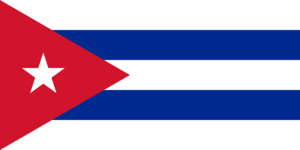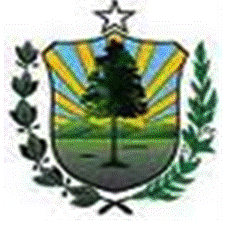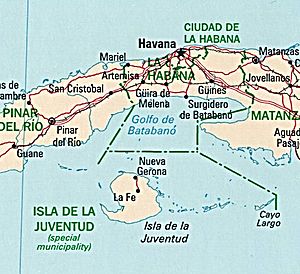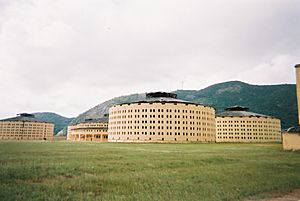Isla de la Juventud facts for kids
| Isla de la Juventud Statistics | |
|---|---|
| Capital: | Nueva Gerona |
| Area: | 2,419.27km² |
| Inhabitants: | 86,559 |
| Population Density: | 35.78 per km² |
| Isla de la Juventud Map | |
The Isle of Youth (Isla de la Juventud in Spanish) is the second-largest island in Cuba. It is also the sixth-largest island in the Caribbean. The island covers about 3,056 square kilometers (1,180 sq mi). It is located about 100 kilometers (62 mi) southwest of mainland Cuba, across the Gulf of Batabanó. The island is almost directly south of Havana.
The Isle of Youth is special because it is not part of any province. Instead, it is a "Special Municipality" and is managed directly by the Cuban government. This is because of its size, population, and how important its economy is.
This island is the biggest of the 350 islands in the Canarreos Archipelago. About 100,000 people live here. The main city and capital is Nueva Gerona, located in the north. The second-largest and oldest city is Santa Fe, found more inland. Other smaller towns include Columbia, Mac Kinley, Santa Bárbara, and Punta del Este. Before 1978, the island was known as the Isle of Pines (Isla de Pinos).
Contents
Discovering the Isle of Youth
Little is known about the island's history before Europeans arrived. However, there are 235 ancient drawings in a cave complex near Punta del Este beach. These were made by the people who lived there long ago.
The island was first seen by Europeans during Christopher Columbus's third trip to the New World in 1494. Columbus named it La Evangelista. He claimed it for Spain. Over time, the island was also called Isla de Cotorras ("Isle of Parrots") and Isla de Tesoros ("Treasure Island").
Pirates and Famous Stories
The area around the island was a popular spot for pirates. Their adventures here even inspired famous books! Both Treasure Island by Robert Louis Stevenson and Peter Pan by James Matthew Barrie were partly based on stories from this island. These tales included details about the island's native people, pirates, long dugout canoes, and the large American crocodiles that live there.
Who Owns the Island?
After the Spanish–American War in 1898, Spain gave up its claims to Cuba. However, the Isle of Youth was not clearly mentioned in the agreement that set Cuba's borders. This led to a disagreement between the United States and the newly independent Cuba about who owned the island.
In 1907, the U.S. Supreme Court decided that the island did not belong to the United States. Finally, in 1925, a treaty was signed between the U.S. and Cuba. This treaty officially recognized that the Isle of Youth belonged to Cuba.
Nature and Economy
A big part of the island is covered with pine forests. These forests are important for the island's lumber industry. In the northern part of the island, there are low hills where marble is dug out from the ground. The southern part is a flat, raised area.
The main jobs on the island are farming and fishing. Farmers grow citrus fruit like oranges and grapefruits, as well as many different vegetables. There is also a unique black sand beach on the island, which was formed by ancient volcanic activity.
The island has a mild climate, meaning the weather is generally pleasant. However, it is known for having frequent hurricanes.
Tourism and Beaches
The Isle of Youth is a popular place for tourists. It has many beautiful beaches and resorts, including the famous Bibijagua Beach. Before the Cuban government took over all foreign-owned property in the early 1960s, many Americans owned land on the island.
Getting Around
The main ways to travel to the island are by boat or by plane. Fast boats called Hydrofoils and motorized catamarans can make the trip in about two to three hours. There is also a slower, larger cargo ferry that takes around six hours, but it is cheaper. The island itself is the only municipality in this special region.
Historic Prisons
From 1953 to 1955, Fidel Castro, who later became Cuba's leader, was held in the Presidio Modelo prison on the Isle of Youth. He was imprisoned by the government of Fulgencio Batista after a failed attack on the Moncada Barracks.
Later, after the Cuban Revolution, Castro used the same prison to hold people who disagreed with his government. One famous prisoner was Huber Matos, who was once a leader in the revolution but later had conflicts with the government.
Today, the Presidio Modelo prison is closed and has been turned into a museum. Newer prisons have replaced it, such as:
- Prison El Guayabo (a maximum security prison)
- Center for Reeducation of Minors (for young people)
- Correctional Los Colonos
- Paquito Rosales Cueto
- Prison la 60 (Columbia)
Images for kids
See also
 In Spanish: Isla de la Juventud para niños
In Spanish: Isla de la Juventud para niños







